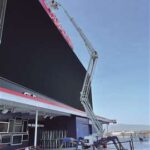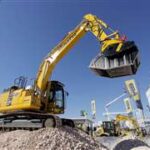The main differences between a vertical mast lift and a scissor lift lie in their design, movement, and typical applications. Both are types of aerial work platforms used to elevate workers, but they each have unique features that make them suitable for different tasks.
1. Design and Structure
-
Vertical Mast Lift:
-
It has a single vertical mast with a platform that rises straight up and down.
-
The platform is typically smaller and narrower, designed for use in tight or confined spaces.
-
The lift’s mast extends vertically to provide the elevation, which makes the lift highly maneuverable in narrow aisles.
-
-
Scissor Lift:
-
It uses a series of crisscrossing metal supports (scissor mechanism) to elevate the platform.
-
This lift has a broader, more stable base compared to the vertical mast lift, providing more space on the platform.
-
The platform raises and lowers by expanding and collapsing the “scissor” mechanism, providing a larger area for multiple workers or equipment.
-
2. Movement and Range
-
Vertical Mast Lift:
-
The mast lifts the platform vertically, so it moves in a straight line up and down.
-
Typically offers a more compact and precise lift, ideal for reaching specific spots, such as over shelving or through narrow aisles.
-
It usually has a lower maximum height compared to scissor lifts (often up to 50 feet / 15 meters).
-
-
Scissor Lift:
-
The platform moves vertically, but the overall base width increases as it rises due to the scissor mechanism.
-
Generally offers a larger maximum height (up to 60 feet / 18 meters or more) than vertical mast lifts, making it more suitable for large-scale tasks.
-
It is more stable than a vertical mast lift, especially at higher elevations, due to the wide base.
-
3. Stability
-
Vertical Mast Lift:
-
While compact, it is less stable when compared to a scissor lift, especially at higher elevations. This makes it better suited for shorter heights or confined spaces.
-
It’s often used in tight spaces where a larger, wider base would not fit.
-
-
Scissor Lift:
-
Offers more stability, especially at higher elevations, because the scissor mechanism spreads the weight across a wider base.
-
This makes it more suitable for tasks requiring a larger, more stable work platform, such as heavier-duty lifting or work on uneven surfaces.
-
4. Platform Size
-
Vertical Mast Lift:
-
The platform is typically smaller, designed for single-person use or smaller tasks in confined spaces.
-
It is more suited for precision work like maintenance, electrical work, or tasks in aisles between shelves.
-
-
Scissor Lift:
-
The platform is larger and can accommodate multiple workers or more equipment at once.
-
Ideal for jobs like painting large surfaces, construction, or warehouse tasks where more space on the platform is required.
-
5. Applications
-
Vertical Mast Lift:
-
Ideal for: Narrow aisles, tight indoor spaces, and low-level tasks such as maintenance work, high shelving, or inspection in smaller areas.
-
It’s a good choice when maneuverability in a confined space is the priority.
-
-
Scissor Lift:
-
Ideal for: Larger, more open spaces where height is needed along with a stable platform. Often used in construction, warehouse, and general maintenance tasks where workers need to access high areas in a safe and stable way.
-
6. Mobility and Footprint
-
Vertical Mast Lift:
-
Easier to maneuver in tight spaces due to its smaller footprint and smaller size.
-
Ideal for tasks where space constraints are significant.
-
-
Scissor Lift:
-
Requires more space to operate and maneuver, as the base becomes wider as the platform rises.
-
Not suitable for narrow aisles or spaces with limited clearance.
-
Summary of Differences:
| Feature | Vertical Mast Lift | Scissor Lift |
|---|---|---|
| Movement | Vertical, straight up and down | Vertical, with widening base as platform rises |
| Height Range | Up to 50 feet (15 meters) | Typically up to 60 feet (18 meters) or more |
| Platform Size | Smaller, for single-person use | Larger, accommodates multiple workers or equipment |
| Stability | Less stable at higher heights | More stable, especially at higher heights |
| Design | Compact, single mast | Wide base, scissor mechanism for stability |
| Applications | Tight spaces, narrow aisles, low-level tasks | Larger, open spaces, heavy-duty lifting tasks |
-
Vertical mast lifts are more suited for confined spaces where precision is key, and the platform needs to move vertically with minimal horizontal movement.
-
Scissor lifts are better for larger areas where stability is crucial and when a bigger platform is needed for multiple workers or equipment at higher elevations.
Choosing between the two depends on the specific work environment and the task at hand.




